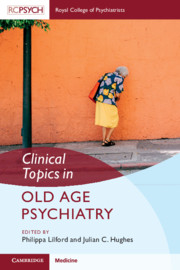Book contents
- Clinical Topics in Old Age Psychiatry
- ‘Clinical Topics In … ’
- Clinical Topics in Old Age Psychiatry
- Copyright page
- Dedication
- Contents
- Contributors
- Preface
- Acknowledgement
- Editors’ Note
- Abbreviations
- Introductory Comments
- Section 1 Epidemiology and Types of Disorders
- Section 2 Assessment and Investigations
- Section 3 Approaches to Management
- Section 4 Law, Ethics, and Philosophy
- Index
- References
Section 3 - Approaches to Management
Published online by Cambridge University Press: 12 September 2020
- Clinical Topics in Old Age Psychiatry
- ‘Clinical Topics In … ’
- Clinical Topics in Old Age Psychiatry
- Copyright page
- Dedication
- Contents
- Contributors
- Preface
- Acknowledgement
- Editors’ Note
- Abbreviations
- Introductory Comments
- Section 1 Epidemiology and Types of Disorders
- Section 2 Assessment and Investigations
- Section 3 Approaches to Management
- Section 4 Law, Ethics, and Philosophy
- Index
- References
- Type
- Chapter
- Information
- Clinical Topics in Old Age Psychiatry , pp. 191 - 278Publisher: Cambridge University PressPrint publication year: 2020



